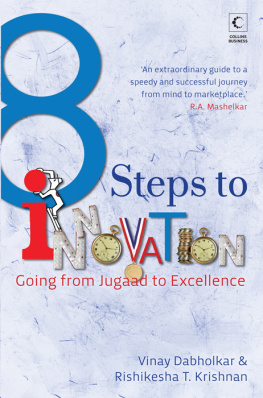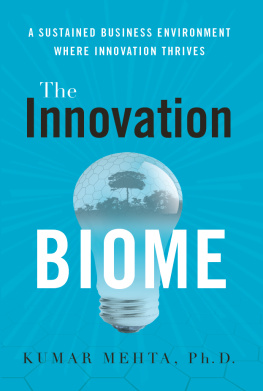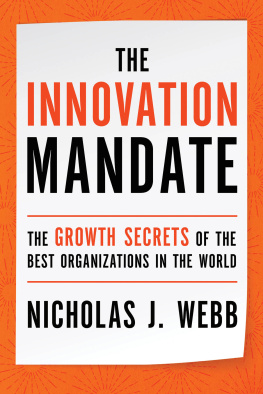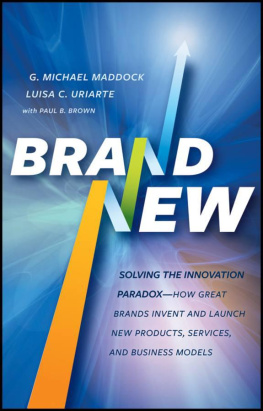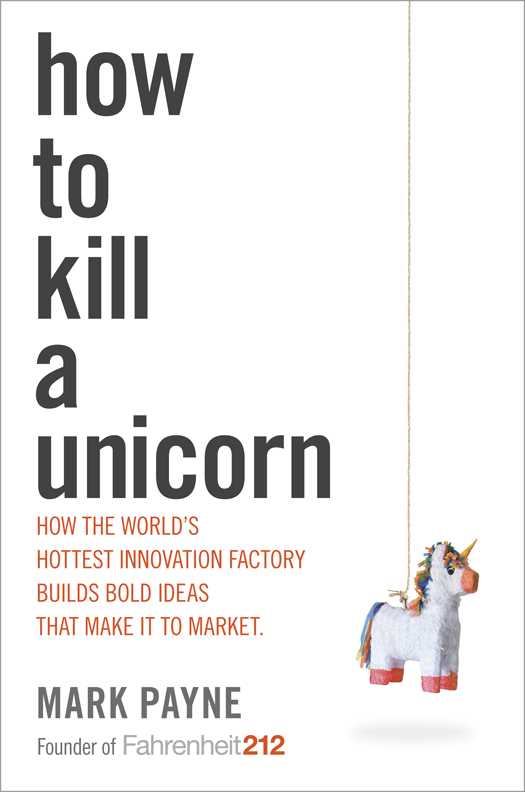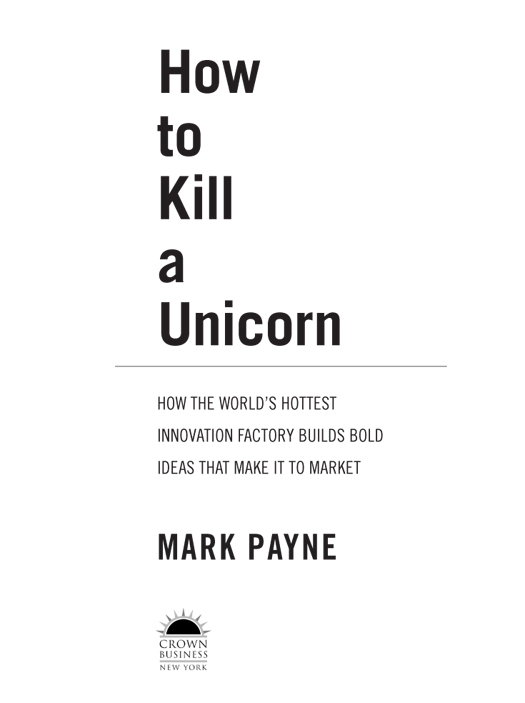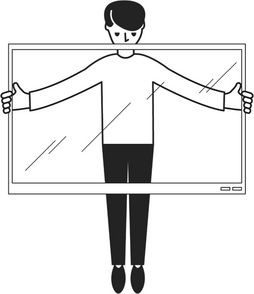Copyright 2014 by Fahrenheit 212
All rights reserved.
Published in the United States by Crown Business, an imprint of the Crown Publishing Group, a division of Random House LLC, a Penguin Random House Company, New York.
www.crownpublishing.com
CROWN BUSINESS is a trademark and CROWN and the Rising Sun colophon are registered trademarks of Random House LLC.
Library of Congress Cataloging-in-Publication data is available upon request.
ISBN 978-0-8041-3873-4
eBook ISBN 978-0-8041-3874-1
Jacket design: Chris Cook
Jacket photograph: Chris Cook
v3.1_r1
This is dedicated to anyone who ever reached, stretched, dreamed, wondered, tried, tried again, and finally found a way to push the boundaries of possibility.
To restless thinkers and tinkerers like John Lee Love, whose invention of the portable pencil sharpener in 1897 saved this book from being overly blunt, and Hymen Lipman, for the tender mercies of the eraser in 1857.
To my past and present colleagues at Fahrenheit 212, the spectacular band of brothers and sisters who amaze me daily.
But above all, and with all my heart, this is dedicated to my remarkable family.
To Elizabeth and Jacob, my brilliant, loving wife and incredible son, your imagination, puns, and patience have inspired me beyond measure. Neither the journey in these pages nor the harvesting of its lessons could have ever happened without the light you bring to my days and my spirit.
Todd, you filled my life with music.
Mom, you showed me the joyful rhythm of a phrase well turned.
Dad, you taught me the immense satisfaction of a job well done.
Contents
Foreplay
As innovators, we are powered by inspiration, but measured in realization.
No unicorns were harmed in the making of this book.
Unicorns arent real.
Chapter 1
Seeing Through It
Its Cool, but So What?
It just might be the coolest technology weve ever seen.
Were sitting in Fahrenheit 212s offices, watching as grainy YouTube clips roll by, one after the other. In a rapid-fire montage of short video reports, a string of tech reporters from various corners of the globe sound as breathless as kids on Christmas morning.
The object of their awed fascination is a new translucent LCD screen technology Samsung has unveiled at the Consumer Electronics Show in Las Vegas. Showcased on a sleek fourteen-inch laptop, the translucent screens cause a feeding frenzy among the tech paparazzi working the floor. Shooting video for their audiences back home, the reporters cant resist waving their hands behind the see-through screen as they proclaim it to be the most amazing thing theyve seen in ages.
Welcome to another Fahrenheit 212 project briefing. On a crisp June afternoon, a dozen of us on Fahrenheit 212s Samsung teaman amalgam of strategists, analysts, financial black belts, writers, designers, architects, film producers, and conceptual thinkers, are gathered around the back bar of our office in Manhattans West Village. In aggregate, the team spans what we call the Money and the Magic. They make up the two sides of our philosophy, our team structure, and our model for developing high-impact innovation solutions. It is the way we create new strategies, ideas, products, categories, and businesses.
The Money & Magic model is in essence an innovation aimed at innovation. Its purpose is to turn the pursuit of breakthrough ideas from a hopeful hit-or-miss rain dance in search of random lightning strikes, into the reliable growth engine modern business needs innovation to be. Money & Magic does this by forcing the collision of two power sources that have traditionally been kept apartuser-centered creativity and outcome-driven commercial grunt. The two forces are joined at the hip in full-bore end-to-end collaboration. Each side of the business comes to a project with equal intensity, equal influence, and equal accountability in shaping high-impact innovation solutions.
Embedded in our approach to new ideas are hard-earned lessons about what separates innovations that work from those that dont. The ones that work make it to market and make good money. The ones that dont are what we call unicornsideas that are lovely to think about but dont become real. The lessons here are designed to help any innovatorfrom the Fortune 500 C-suite exec to the startup entrepreneur to your next-door neighbor tinkering in his garage to your cousin building apps in his dorm roomturn ambition, sweat, and the alchemy of human imagination into real products and businesses that change peoples lives.
My colleagues and I gather for project briefings like this kickoff for Samsungs translucent screens around this same worktable every week. As kids kick balls around the park below us, we kick around visions of the future up here. Many of the worlds great companies invite us to help crack their most strategically important, commercially critical innovation challenges across a spectrum of businesses. From software to soft drinks. Money to music. E-commerce to eco-packaging. Hotels to haute jewels. Wellness to whiskey. Microchips to potato chips. Resorts to retail. Fashion to factory equipment. Productivity tools to perfume. Textiles to high-tech manufacturing systems. Lipstick to life insurance. And literally soup to nuts. The running joke around the company is that weve turned ADD into a business model.
As the video clips run and the buzz builds, project point man Jon Crawford-Phillips has seen enough. An eloquent pragmatist of British upbringing, Crawford-Phillips is an embodiment of Money & Magic. He hops off his bar stool and shuts down the video feed. In the silence that follows, he walks to the glass wall in front of the back bar where we jot down ideas, grabs a marker, and writes five words.
Its cool. But so what?
Pointing at the words on the wall, he turns toward the rest of the group. Thats the question Samsung has asked us to answer. We have four months to solve it.
What Jon means is that our assignment is to help Samsung turn this cool technology from something interesting into something valuable. What lies ahead is a rapid march through a gauntlet of high-stakes questions. For starters, where should Samsung point this amazing technology? Dozens of industries are fair game. Within any of them, what pain points and unmet needs would translucent LCD address and for whom? What new user experiences, benefits, business models, revenue streams, and competitive advantages would it ignite? What would it replace? What specific products would be the door kickers to begin a revolution? What would those products do and how would they work? And in a technology sector that moves at light speed, how could Samsung get to this bold see-through future faster than competitors who might be chasing similar science?
Solving an innovation challenge like this is a bit like wrestling an octopus. Pin down one arm and another wriggles loose. Before diving into the variables we have to start with the few fixed parameters we have. In this case there are just two: the technology itself and the capabilities of the company behind it.


